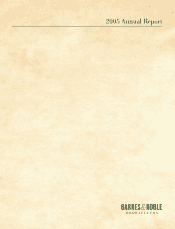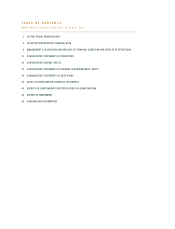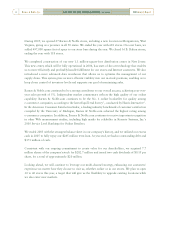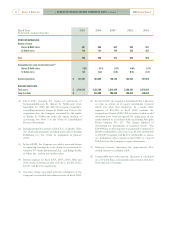Barnes and Noble 2005 Annual Report Download - page 10
Download and view the complete annual report
Please find page 10 of the 2005 Barnes and Noble annual report below. You can navigate through the pages in the report by either clicking on the pages listed below, or by using the keyword search tool below to find specific information within the annual report.
1Based upon sales reported in trade publications and public filings.
9
2005 Annual Report ■Barnes & Noble, Inc.
MANAGEMENT’S DISCUSSION AND ANALYSIS
OF FINANCIAL CONDITION AND RESULTS OF
OPERATIONS
Barnes & Noble, Inc.’s (Barnes & Noble or the
Company) fiscal year is comprised of 52 or 53 weeks,
ending on the Saturday closest to the last day of
January. As used in this section, “fiscal 2006”
represents the 53 weeks ending February 3, 2007,
“fiscal 2005” represents the 52 weeks ended January
28, 2006, “fiscal 2004” represents the 52 weeks ended
January 29, 2005 and “fiscal 2003” represents the 52
weeks ended January 31, 2004.
GENERAL
The Company is the nation’s largest bookseller1, and as
of January 28, 2006 operated 799 bookstores and a
Web site. Of the 799 bookstores, 681 operate primarily
under the Barnes & Noble Booksellers trade name (27
of which were opened in fiscal 2005) and 118 operate
primarily under the B. Dalton Bookseller trade name.
Barnes & Noble conducts the online part of its business
through barnesandnoble.com llc (Barnes &
Noble.com), one of the largest sellers of books on the
Internet. Through Sterling Publishing Co., Inc.
(Sterling), the Company is a leading general trade book
publisher. Additionally, the Company owns an
approximate 74% interest in Calendar Club L.L.C.
(Calendar Club), an operator of seasonal kiosks. The
Company employed approximately 39,000 full- and
part-time employees as of January 28, 2006.
Barnes & Noble stores are located in all 50 states and
the District of Columbia as of January 28, 2006. With
40 years of bookselling experience, management has a
strong sense of customers’ changing needs and the
Company leads book retailing with a “community
store” concept. Barnes & Noble’s typical store offers a
comprehensive title base, a café, a children’s section, a
music department, a magazine section and a calendar of
ongoing events, including author appearances and
children’s activities, that make each Barnes & Noble
store an active part of its community.
Barnes & Noble stores range in size from 10,000 to
60,000 square feet depending upon market size with an
overall average store size of 25,000 square feet. Each
store features an authoritative selection of books,
ranging from 60,000 to 200,000 unique titles. The
comprehensive title selection is diverse and tailored to
each store location to reflect local interests. In addition,
Barnes & Noble emphasizes books published by small
and independent publishers and university presses.
Bestsellers (the “top ten” highest selling hardcover
fiction, hardcover non-fiction and trade paperback
titles) typically represent between 3% and 5% of Barnes
& Noble store sales. Complementing this extensive in-
store selection, all Barnes & Noble stores provide
customers with on-site access to the millions of books
available to online shoppers while offering an option to
have the book sent to the store or shipped directly to the
customer through the Barnes & Noble.com delivery
system. All Barnes & Noble stores are equipped with its
proprietary BookMaster in-store operating system,
which enhances the Company’s merchandise-
replenishment system, resulting in high in-stock
positions and productivity at the store level through
efficiencies in receiving, cashiering and returns
processing. The Company has integrated the
BookMaster system used in its stores with Barnes &
Noble.com so that its customers share the same
experience across both channels.
During fiscal 2005, the Company added 0.5 million
square feet to the Barnes & Noble store base, bringing
the total square footage to 16.9 million square feet, a
3% increase over the prior year. Barnes & Noble stores
contributed approximately 85% of the Company’s total
sales in fiscal 2005. The Company plans to open
between 30 and 40 Barnes & Noble stores in fiscal
2006, which are expected to average 28,000 square feet
in size.
At the end of fiscal 2005, the Company operated 118 B.
Dalton bookstores in 37 states and the District of
Columbia. B. Dalton bookstores employ merchandising
strategies that target the mainstream consumer book
market, offering a wide range of bestsellers and general-
interest titles. Most B. Dalton bookstores range in size
from 2,000 to 6,000 square feet, and while they are
appropriate to the size of adjacent mall tenants, the
opening of book superstores in nearby locations
continues to have a significant adverse impact on B.
Dalton bookstores.
The Company is continuing its controlled descent in the
number of its smaller format B. Dalton bookstores in
response to declining sales attributable primarily to
book superstore competition. Part of the Company’s
strategy has been to close underperforming stores,
which has resulted in the closing of 849 B. Dalton
bookstores since 1989.
On September 15, 2003, the Company completed its























